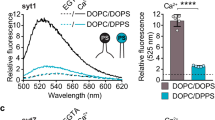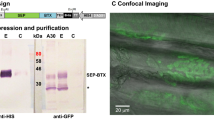Abstract
LIGHT scattering and birefringence changes1 support recent “conformational” theories of nerve activity2, and Tasaki has shown that an action potential requires only the presence of univalent ions within the nerve axon and of divalent ions externally2; this recalls initiation of action potentials in poly-acrylic acid membranes by dilatory (alkali), followed by contractile (acid) stimuli3. Nerve membrane movements might therefore be swelling changes arising from divalent–monovalent ion-exchange. Heald has isolated from nervous tissue a lipophosphatidylserine peptide which he suggested could function as cation-exchange membrane sites4. Here I use Heald's suggestion to show how the properties to be expected of such a lipo protein, or related polymers, can account for action potentials in nerve.
This is a preview of subscription content, access via your institution
Access options
Subscribe to this journal
Receive 51 print issues and online access
$199.00 per year
only $3.90 per issue
Buy this article
- Purchase on Springer Link
- Instant access to full article PDF
Prices may be subject to local taxes which are calculated during checkout
Similar content being viewed by others
References
Cohen, L. B., Keynes, R. D., and Hille, B., Nature, 218, 438 (1968).
Tasaki, I., Nerve Excitation: A Macromolecular Approach (C. C. Thomas, Springfield, Ill., 1967). Changeux, J. P., Thiery, J., Tung, Y.., and Kittel, C., Proc. US Nat. Acad. Sci., 57, 335 (1967).
Walters, D. H., Kuhn, W. and Kuhn, H. J., Nature, 189, 381 (1961).
Heald, P. J., Nature, 193, 451 (1962); Biochem. J., 78, 340 (1961); ibid., 80, 510 (1961).
Keder, W. E., Martin, Z. C., and Bray, L. A., Solvent Extraction Chemistry of Metals, Proc. Int. Conf. Harwell, 343 (Macmillan, London, 1968); USAEC Report, BNWL-SA-273; Nucl. Sci. Eng., 20, 362 (1964).
Kilbourn, B. T., Dunitz, J. D., Pioda, L. A. R., and Simon, W., J. Mol. Biol., 30, 559 (1967).
Pressman, B. C., Fed. Proc., 27, 1283 (1968).
Pedersen, C. J., Fed. Proc., 27, 1305 (1968).
Howarth, J. V., Keynes, R. D., and Ritchie, J. M., J. Physiol., 194, 745 (1968).
Hodgkin, A. L., and Katz, B., J. Physiol., 109, 240 (1949). Spyropoulos, C. S., J. Gen. Physiol., 48, 49 (1965).
Seeman, P., Int. Rev. Neurobiol., 9, 145 (1966).
Frank, G. B., and Sanders, H. D., Brit. J. Pharmacol., 21, 1 (1963).
Frankenhauser, B., and Hodgkin, A. L., J. Physiol., 137, 218 (1957). Coutinho, E. M., J. Gen. Physiol., 49, 845 (1966).
Kuperman, A. S., Altura, B. T., and Chezar, J. A., Nature, 217, 673 (1968).
Holan, G., Nature, 221, 1025 (1969).
Gordon, H. T., and Welsh, J. H., J. Cell. Comp. Physiol., 31, 395 (1948). Narahashi, T., and Haas, H. G., J. Gen. Physiol., 51, 177 (1968).
Baker, P. F., Brit. Med. Bull., 24, 179 (1968).
Weiss, D. E., Austral. J. Biol. Sci. (in the press).
Author information
Authors and Affiliations
Rights and permissions
About this article
Cite this article
WEISS, D. Action Potential Model based on a Lipophosphoprotein. Nature 223, 634–635 (1969). https://doi.org/10.1038/223634a0
Received:
Revised:
Issue Date:
DOI: https://doi.org/10.1038/223634a0
Comments
By submitting a comment you agree to abide by our Terms and Community Guidelines. If you find something abusive or that does not comply with our terms or guidelines please flag it as inappropriate.



